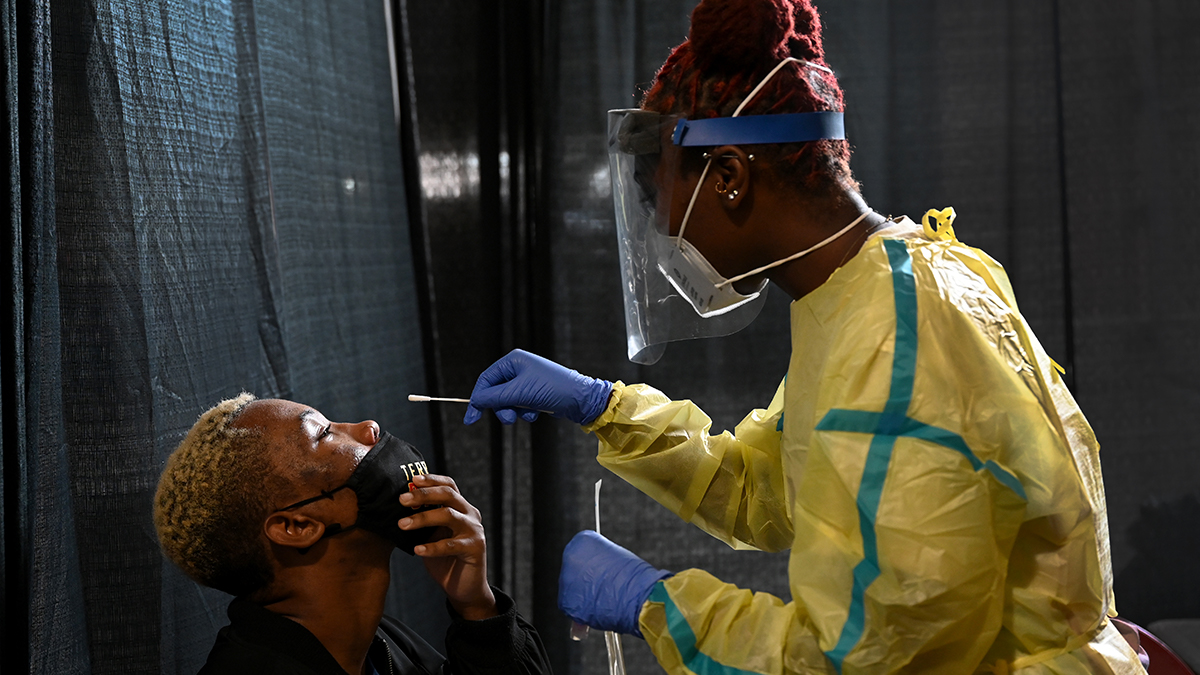Local leaders are monitoring as coronavirus cases continue to surge across D.C., Maryland and Virginia.
Visitors coming from certain coronavirus hotspots will be required to quarantine for two weeks unless they are on essential business, Mayor Muriel Bowser said on Friday.
It won't apply to Maryland and Virginia. On Monday, the city will post a list of the areas that are considered high-risk.
Bowser also said phase two reopening could be dialed back if necessary.
Still, residents within the D.C. area are eager to shake off a complete quarantine.
During the Nationals' Opening Day, groups sat at tables around Navy Yard, separated by a six-foot distance. And on Friday, two favorite places are reopening: the National Zoo and the Smithsonian Air and Space Museum's Udvar-Hazy Center. Both will allow entry via timed tickets.
Bowser said that it's necessary to slow the virus spread so kids can go back to school, for their education as well as social and emotional health.
She expressed concern that people may be forgetting to follow advice that can mitigate coronavirus risk, such as wearing masks and staying home.
Coronavirus is spreading more through the D.C. community, meaning more people are catching the virus and it's not clear who they got it from.
Declining community spread is one of the city's key goals, and right now things are getting worse.
And as the number of people hospitalized in the District grew on Friday, United Medical Center hospital was grappling with a power outage. D.C.'s public hospital was forced to move patients in the intensive care unit to other hospitals.
What the Data Shows
Maryland and Virginia added a large number of coronavirus cases to their databases on Friday.
In Maryland, 930 more people were diagnosed, the most since May 30.
In Virginia, 1071 people were confirmed to have COVID-19, the largest increase since June 7.
Hospitalizations still rising, hitting 533 in Maryland and 799 in Virginia. In the District, hospitals are treated 97 coronavirus parents, the largest number since July 3.
The map below shows the number of coronavirus cases diagnosed per 1,000 residents.
Coronavirus Cases in DC, Maryland and Virginia
COVID-19 cases by population in D.C. and by county in Maryland and Virginia
Source: DC, MD and VA Health Departments
Credit: Anisa Holmes / NBC Washington
Local Coronavirus Headlines
- The National Air and Space Museum opens its Udvar-Hazy Center in Chantilly, Virginia, on Friday, giving an idea of what museums may have to do to enforce social distancing. More.
- Washington Nationals star outfielder Juan Soto tested positive for COVID-19 and missed Opening Day in D.C. Thursday. Read more.
- Amid growing concerns about a surge in coronavirus cases this month, a group of nurses gathered outside of Washington MedStar Hospital to voice concerns about their safety on the job. Watch the report.
- Maryland will allow local school districts to make the call on when it's appropriate to reopen, State Superintendent of Education Karen Salmon said Wednesday.
- The District implemented strict new mask guidelines, saying face coverings must be worn whenever you leave home, with few exceptions. Read more.
- D.C. will empower inspectors to issue on-the-spot citations to businesses that violate social distancing rules.
- Fairfax County Public Schools has shifted to a 100%-online start to the school year, citing health data. Read more.
Reopening Tracker
- Virginia entered phase three reopening on July 1, loosening restrictions on restaurants, stores, gyms and pools. But Gov. Northam said more restrictions could be implemented if cases continue to grow.
- Prince George's County entered full phase two on June 23, allowing the MGM Casino and gyms to reopen.
- Washington, D.C., entered phase two on June 22, allowing indoor dining, gyms, libraries and houses of worship to reopen with restrictions.
- Montgomery County entered phase two on June 19, reopening with restrictions gyms, houses of worship, indoor dining and retail.
- Maryland entered phase two of reopening on June 10, permitting indoor dining, outdoor pools and outside amusements to reopen.
How to Stay Safe
There are ways to lower your risk of catching coronavirus. Here are the CDC guidelines.
- Wear a snug-fitting mask that covers your nose and mouth.
- Avoid being indoors with people who are not members of your household. The more people you are in contact with, the more likely you are to be exposed to COVID-19. If you are indoors with people you don’t live with, stay at least six feet apart and keep your mask on.
- Wash your hands often, especially after you have been in a public place.
Sophia Barnes, Andrea Swalec and Anisa Holmes contributed to this report



